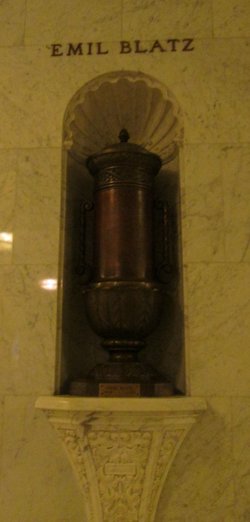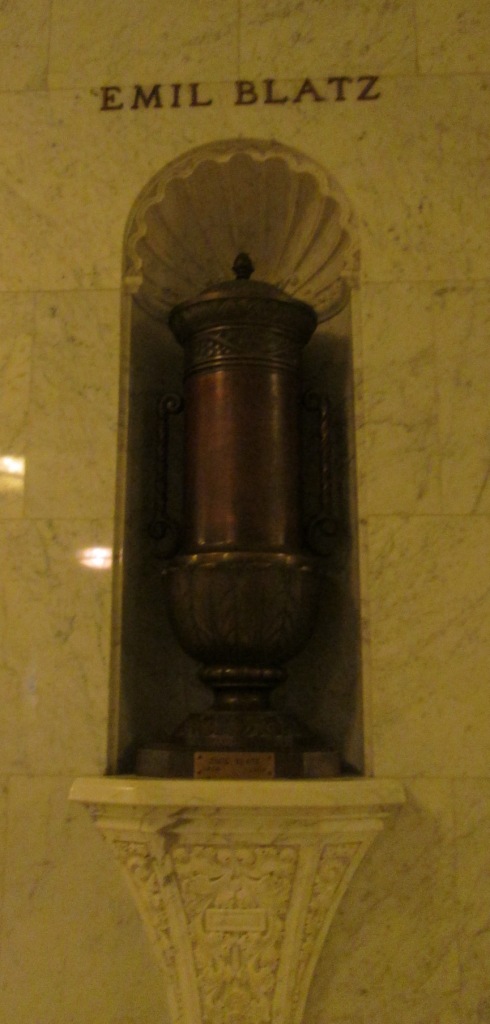Music Temple Donor is Dead
Emil Blatz Succumbs to Heart Attack; Lived a Retiring Life
Emil Blatz, who gave Milwaukee its $100,000 bandshell and amphitheater in Washington park because he wanted the people of his town to hear the good music which he loved, died Monday morning at Columbia hospital. He was 86.
He had returned from a trip in the south Wednesday and suffered a heart attack Sunday morning. He was removed to the hospital to which he had only recently given money for completion of the second floor of the new west wing, to be called the Emma C. Blatz pavilion in memory of his wife.
A modest, retiring man, Mr. Blatz kept from the public eye until 1938 when his gift of the Blatz Temple of Music to Milwaukee brought him to the attention of its citizens. During the years since the Temple's dedication, Mr. Blatz could often be found among the members of the Music Under the Stars audience which crowded the amphitheater to capacity each summer. In 1942 he presented a huge American flag for which the county park commission erected a special flagpole near the bandshell.
Emil Blatz was born at the southwest corn of Broadway and Juneau May 8, 1858. He was one of four children of Valentine Blatz, who at that time had the beginnings of a large brewery and was president of the new Second Ward bank. Young Emil went to work in the bank at 14. He had earlier attended Peter Engelmann's school, now the Milwaukee University school. At the bank he rose from messenger to bookkeeper in the savings department.
In 1877 Mr. Blatz went to his father's brewery and there he worked until 1888 as bookkeeper, cashier and finally traveling auditor, going to the many cities where the brewery had offices. It was in that year that Emil Blatz retired from active business and little was heard from him by those who did not know him until his eightieth year, when his philanthropy brought him into the public eye.
At that time he was making his home at 3800 N. Lake dr., on the grounds where Milwaukee's first country club once stood. In the airy old mansion, remodeled and redecorated, he and his wife lived for years. When she died in 1921 Emil Blatz continued to make it his home. About 1922 he sold the northern part of the big lot and upon the southern half build the whitish brick edifice that stands there today with its two marble sphinxes at the entrance steps.
His one great passion next to his house was travel. He went often to Germany, where he enjoyed the music, and to England, Ireland and Scotland. He made 10 or 12 trips to Europe with his wife before her death. After she died he continued to travel alone.
Among his friends he numbered the Mayo doctors at Rochester, Minn., Will and Charles, and their father, Dr. William Worall Mayo, and went often to visit them. Another friend with whom he spent much time during the years of his retirement was George Bartlett of Chicago. But usually he remained alone at his home in Milwaukee, spending his time checking his mail with his secretary, giving--often anonymously--to charities, visiting the bank and listening to news broadcasts and music on his radio.
In 1938, after his gift of the music temple, he received the Cosmopolitan club's distinguished service award. At the presentation ceremony he was described as contributing "a new vision to Milwaukee--a city glorified in music."
A bronze plaque bearing his likeness is affixed to the Temple of Music.
One of Emil Blatz's dreams for Milwaukee was its own symphony orchestra, and he often expressed the hope that it would materialize during his lifetime.
According to his friends, Emil Blatz had no particular musical talent nor had he ever studied music. But he had a friendly feeling toward it and loved to hear happy music--the waltzes of old Vienna, the marches of Sousa, music which had a hit and a melody to it. He often said that "there is too much sadness in the world without listening to it again in music." What he wanted in the band shell was to give happiness "nothing grand, just mama and papa and the kids sitting and listening." He delighted in entertaining the artists who came to the Temple of Music and almost always invited them to his home either before or after their performances.
Mr. Blatz is survived by a sister, Mrs. Gustav A. Kletzsch of Milwaukee, and nieces and nephews. Deceased are his two brothers, Valentine II and Albert Blatz, and a stepsister and step brother who died many years ago.
The body was removed to the Weiss chapel, 1901 N. Farwell Ave. Funeral arrangements will be announced later.
Music Temple Donor is Dead
Emil Blatz Succumbs to Heart Attack; Lived a Retiring Life
Emil Blatz, who gave Milwaukee its $100,000 bandshell and amphitheater in Washington park because he wanted the people of his town to hear the good music which he loved, died Monday morning at Columbia hospital. He was 86.
He had returned from a trip in the south Wednesday and suffered a heart attack Sunday morning. He was removed to the hospital to which he had only recently given money for completion of the second floor of the new west wing, to be called the Emma C. Blatz pavilion in memory of his wife.
A modest, retiring man, Mr. Blatz kept from the public eye until 1938 when his gift of the Blatz Temple of Music to Milwaukee brought him to the attention of its citizens. During the years since the Temple's dedication, Mr. Blatz could often be found among the members of the Music Under the Stars audience which crowded the amphitheater to capacity each summer. In 1942 he presented a huge American flag for which the county park commission erected a special flagpole near the bandshell.
Emil Blatz was born at the southwest corn of Broadway and Juneau May 8, 1858. He was one of four children of Valentine Blatz, who at that time had the beginnings of a large brewery and was president of the new Second Ward bank. Young Emil went to work in the bank at 14. He had earlier attended Peter Engelmann's school, now the Milwaukee University school. At the bank he rose from messenger to bookkeeper in the savings department.
In 1877 Mr. Blatz went to his father's brewery and there he worked until 1888 as bookkeeper, cashier and finally traveling auditor, going to the many cities where the brewery had offices. It was in that year that Emil Blatz retired from active business and little was heard from him by those who did not know him until his eightieth year, when his philanthropy brought him into the public eye.
At that time he was making his home at 3800 N. Lake dr., on the grounds where Milwaukee's first country club once stood. In the airy old mansion, remodeled and redecorated, he and his wife lived for years. When she died in 1921 Emil Blatz continued to make it his home. About 1922 he sold the northern part of the big lot and upon the southern half build the whitish brick edifice that stands there today with its two marble sphinxes at the entrance steps.
His one great passion next to his house was travel. He went often to Germany, where he enjoyed the music, and to England, Ireland and Scotland. He made 10 or 12 trips to Europe with his wife before her death. After she died he continued to travel alone.
Among his friends he numbered the Mayo doctors at Rochester, Minn., Will and Charles, and their father, Dr. William Worall Mayo, and went often to visit them. Another friend with whom he spent much time during the years of his retirement was George Bartlett of Chicago. But usually he remained alone at his home in Milwaukee, spending his time checking his mail with his secretary, giving--often anonymously--to charities, visiting the bank and listening to news broadcasts and music on his radio.
In 1938, after his gift of the music temple, he received the Cosmopolitan club's distinguished service award. At the presentation ceremony he was described as contributing "a new vision to Milwaukee--a city glorified in music."
A bronze plaque bearing his likeness is affixed to the Temple of Music.
One of Emil Blatz's dreams for Milwaukee was its own symphony orchestra, and he often expressed the hope that it would materialize during his lifetime.
According to his friends, Emil Blatz had no particular musical talent nor had he ever studied music. But he had a friendly feeling toward it and loved to hear happy music--the waltzes of old Vienna, the marches of Sousa, music which had a hit and a melody to it. He often said that "there is too much sadness in the world without listening to it again in music." What he wanted in the band shell was to give happiness "nothing grand, just mama and papa and the kids sitting and listening." He delighted in entertaining the artists who came to the Temple of Music and almost always invited them to his home either before or after their performances.
Mr. Blatz is survived by a sister, Mrs. Gustav A. Kletzsch of Milwaukee, and nieces and nephews. Deceased are his two brothers, Valentine II and Albert Blatz, and a stepsister and step brother who died many years ago.
The body was removed to the Weiss chapel, 1901 N. Farwell Ave. Funeral arrangements will be announced later.
Family Members
Sponsored by Ancestry
Advertisement
Explore more
Sponsored by Ancestry
Advertisement










